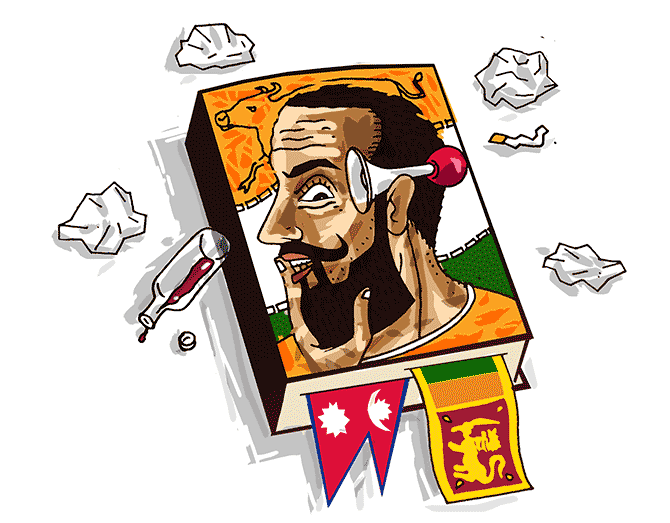 | « Back to article | Print this article |
'There is an observable difference between Nepalis and Lankans and the rest of us.'
'It would serve us well to understand where this difference comes from and, if it is something that is better in some way, how it is that we can access it,' says Aakar Patel.
Illustration: Dominic Xavier/Rediff.com

I was in Nepal a few days ago and noticed an interesting thing. Kathmandu is a city much like any other on our subcontinent. Most people are not wealthy, most houses are modest and there is far more traffic on the road than the infrastructure can handle.
Additionally, for some reason, the traffic signals did not work on many intersections, which needed a policeman to direct traffic.
This could have been the scene anywhere in our parts. The interesting thing was that there was almost no honking, though there was a lot of traffic.
I was in Kathmandu after 20 years and so could not remember if it had always been like this. I asked a local, who said that there had been a law or an order for people to stop honking about a week ago.
I was incredulous and asked if by itself that was sufficient to get people to behave, and I was told yes. The police apparently do not accept bribes.
How remarkable.
The other noticeable thing was that where the road had two (small) lanes on each side, traffic aligned itself perfectly. Those going straight stayed in the lane on the right even if the lane on the left was totally empty and even if the traffic was heavy.
This would never happen in India or any of the other South Asian nations except for one other. I'll come to that other nation (which I also visited a few weeks ago), but for now let me stay with Nepal.
The country has some beautiful and very large temples, the grandest of which is Pashupatinath, a temple to Shiva in Kathmandu. It has a magnificent and enormous metal Nandi bull in the courtyard and readers should search for images on the Internet to be able to appreciate just how striking it is.
The temple's officiating priests are Namboodiris from Kerala and apparently this has been the tradition there for a long time. The Maoists want the local Brahmins to take over, but this has not yet happened.
What is unusual about this temple, is that there is animal sacrifice, including that of a buffalo, inside the premises every month.
It is difficult, if not impossible, to see such a thing in India's major temples. The writer Nirad C Chaudhuri in his autobiography refers to buffalo sacrifice when he was a child (over a century ago) in Bengal.
But with the exception of perhaps one or two places, in India this practice has gone. One could get lynched by a mob if one tries it today.
Nepal seems different.
Another aspect of religious difference is that in Nepal Buddhism is a living religion. They have their own school of Buddhism, called Vajrayana, which is very sensual and unlike anything in India.
The Buddhism in India is limited for the most part to archaeological sites. There is, of course, the new school called Navayana which many Dalits find refuge in, but Buddhism is not very prominent here.
So why does it remain so dominant in the culture in Nepal?
I wish I knew. Nepal has Lumbini and it is where Buddha was born. The Uttar Pradesh Tourism Development Corporation a few years ago claimed Buddha was born on the Indian side of the border, but that claim is not taken seriously.
Nepal also has the Tibetan tradition of Buddhism and one of its most spectacular temples is Swayambhunath, also in Kathmandu.
The visitors there are not separated along Hindu/Buddhist lines and people from both faiths come to it. This reminded me of Hindu/Muslim places in India, like Ajmer and Nizamuddin.
I spoke about another South Asian nation that was not like the others and it is Sri Lanka, which is also Buddhist.
There, of course, the religion is from the Theravada or Hinayana school, which I am familiar with because of Max Mueller who had the Theravada texts translated from Pali.
Visitors to Lanka from India will notice immediately that it doesn't have the dirtiness and chaos and disorderliness of our country. The roads and neighbourhoods are neater and more civilised.
The people are also in some way different, though I don't know why that is. Does the difference come essentially from religion?
I ask because in a part of the world where almost everyone was illiterate about a century ago, religion was the most powerful way in which individuals were informed about culture.
I don't want to speculate further on this today other than to recognise that there is an observable difference between Nepalis and Lankans and the rest of us.
It would serve us well to understand where this difference comes from and, if it is something that is better in some way, how it is that we can access it.
Aakar Patel is Executive Director, Amnesty International India. The views expressed here are his own.
DONT'S MISS the columns in the RELATED LINKS BELOW...